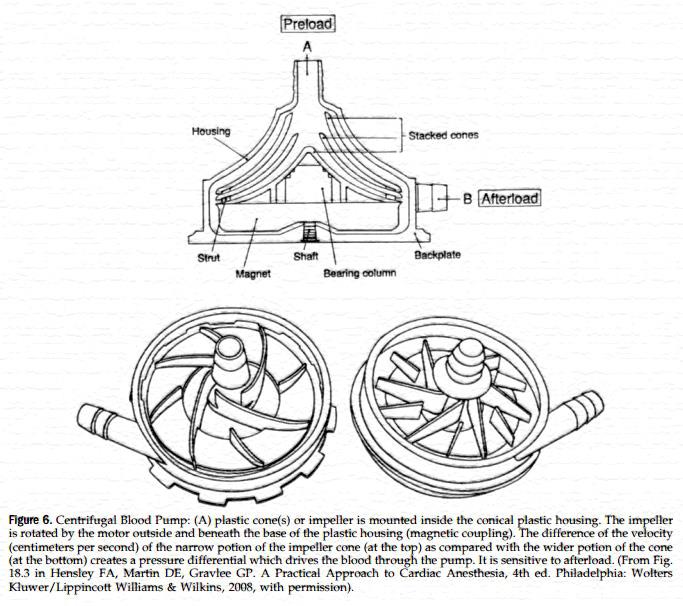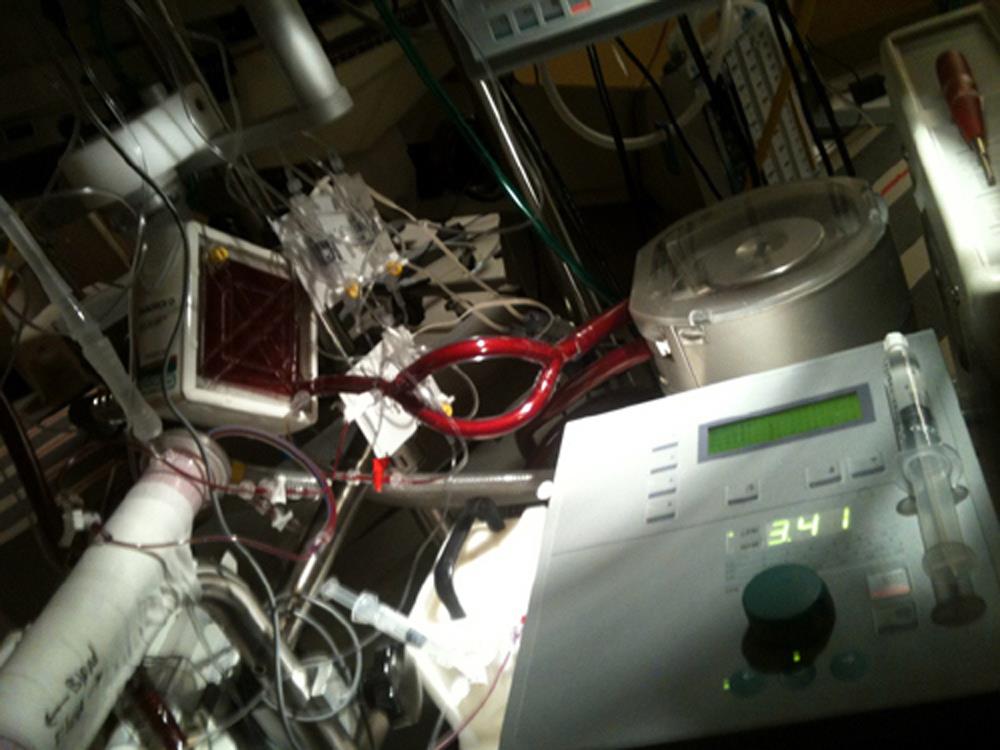Centrifugal vs. Rollerhead Pump? Which is Safer?

“Overall, I like centrifugals, although I do worry if the necessity to hand crank comes up- most systems have been so shortened- getting the awkward and cumbersome centrifugal hand-crank positioned is in most cases- nearly impossible.”

Editor’s Note:
I got the following email this morning:
Dear Staff,
Very early morning greetings from Vermont. I am wondering about switching to centrifugal pumps and whether it really is safer as many say.
I am also wondering about the mortality vs. roller pumps. We currently use these for 500 open hearts per year. Any thoughts? Numbers?
Thanks,
Charlie
Before I throw this out to the readership to offer their insight, I want to say that I have used both extensively in my career. That’s about a 50/50 split- or 12-13 years each.
I started off with rollerheads, and am very comfortable with them, assuming you get your occlusions right- hemolysis is never usually an issue (Perfusion 101). I like them better for vacuum assist as I feel they are just safer when used in tandem with a negative pressure. As well- dropping Q is just plain easier. On the other side of the coin, I LOVE centrifugals for their ease in priming and for the most obvious reason- you wont be clamping the wrong line and blowing up your circuit. Tactile control is slightly different with each type of pump- but I like them both equally.
Overall, I like centrifugals, although I do worry if the necessity to hand crank comes up- most systems have been so shortened- getting the awkward and cumbersome centrifugal hand-crank positioned is in most cases- nearly impossible. I have worked at numerous places where yes there is a hand crank available for the centrigugal, and it is always checked off on the checklist- but upon closer inspection, shortening of the inlet and outlet lines makes hand cranking a horrifying prospect. It was clearly impossible- and to check mark the “yes” box is basically putting your head in the sand and hoping it never happens.
At one institution I brought in a spare biohead console with a servo that would reach to where the centrigugal was located- and could actually be engaged by simply switching over the head- as well as the Q probe in place.
Below are some hard numbers on a very good article I found online.
Any input here is appreciated 🙂
Frank
Reader Comments:
=
Thore H. Pedersen
Centrifugal pumps, are two types, the vortex type (Biomedicus), and impeller type. According to our experience, the first type have a benefit over the impeller, when it comes to micro bubbles. The first type keeps the microbubbles in the center, and and function as a bubble trap. The second type transport the microbubbles through, and further on, in the arterial line. This is based upon several in vitro and in vivo tests by our group, at Rikshospitalet, university hospital of Norway.
Frank Aprile
Thanks for the information- it is very much appreciated 🙂
FB Thread on the Perfusion.com Perfusion Group
-
Weng Puno-Baldeo, Andrei Kirjaev, Domenec Santiago and 21 others like this.
-
-
April Radicella Line it up on an IV pole beforehand….not so bad smile emoticon
-
Viny JS Dkz Crazy I like the roller..
-
April Radicella Nah lol team centrifugal head smile emoticon
-
Rick Price You couldn’t pay me to use a roller.
-
-
 Neville McCann replied · 1 Reply
Neville McCann replied · 1 Reply
-
-
Rick Price Not to mention hand cranking a roller pump is FAR more demanding than cranking a geared crank for centrifugal. If providing adequate room for your hand crank isn’t part of your practice, your are providing “mal”practice.
-
-
Rick Price If you run your pressure shut off below 250 or lower if possible it’s pretty reliable. Ran them for years.
-
-
Neville McCann Anyone tried regulating SACP in DHCA with a centrifugal, with intermittent cardioplegia too??
-
Literature & Discussion
Click on link to view source article
https://www.mnperfsoc.org/images/perfusion_1_.pdf
Optimal Blood Pump Tayama et al. suggested that the ideal blood pump for extracorporeal circulation must have the capacity to deliver up to 7 L per minute against a pressure of 500 mm Hg, should not damage the cellular or acellular components of the blood, should have smooth surfaces, must be free of areas of stasis or turbulence, should have accurate and reproducible flow measurement, and should have a back-up or manual mode of operation where a motor or power failure occur.135 With roller pumps, the propulsion of blood occurs by the action of two rollers sequentially compressing a segment of tubing causing the forward movement of blood (Fig. 5).
The magnitude of hemolysis is related to both the time and exposure of the blood to shear forces generated by the pump. A region of high pressure and shear force is created at the leading edge of the roller where the tubing is compressed, which is followed by period of negative pressure as the tubing expands behind the roller. This momentary negative pressure under certain conditions may induce the cavitation of air dissolved in the solution. Furthermore, particulate emboli may be generated by micro fragmentation (or spallation) of the inner surface of the tubing where the roller contacts the tubing and where the fold at the edges of the tubing occurs.136
Studies of tubing wear over time have shown that polyvinylchloride fragments generated from roller pumps are numerous, frequently 20 m in diameter, and begin to occur during the first hour of use.137 Centrifugal pumps are nonocclusive pumps that function by producing a constrained vortex within a polycarbonate structure that results in the forward movement of fluid (Figs. 5, 6). The rate of flow is dependent on preload from the blood reservoir or blood source and afterload produced by downstream resistance. Blood flow rate is increased by increasing the revolutions per minute of the cone suspended within the polycarbonate housing. The cones or impeller are coupled with a motor drive by magnets. There have been reports of thrombus formation when these pumps are used with low anticoagulation or for prolonged periods of time.138 Improved designs have addressed issues of stasis, heat generation, and bearing wear.
A number of investigators have performed in vitro studies comparing centrifugal pumps and roller pumps in terms of blood handling during short- and long-term use.139 –148 Several studies reported less hemolysis with the centrifugal pump when tested in vitro. 139 –142 Tamari et al. examined hemolysis under various flow and pressure conditions in an in vitro model using porcine blood and concluded that the hemolysis index was related to the duration of blood exposure to shear, the ratio of pump pressure difference between the inflow and outflow and the flow rate of the pump.144 Rawn et al. compared an underocclusive roller pump to a centrifugal pump and found a significantly higher index of hemolysis in the centrifugal pump (3.38 –14.65 vs 29.58 gm/100 L pumped).145
How relevant these often very long-term (24 h or longer) in vitro studies are to relatively short-term (6 h) CPB used for supporting cardiac surgery is not clear. A number of clinical trials have been conducted to compare centrifugal and roller pumps in relation to emboli generation, blood trauma, and clinical outcomes,149 –170 (see Web-based supplementary material for details of clinical investigations). In a trial by Wheeldon et al., significantly less microemboli generation, less complement activation, and better preservation of platelet count was observed in patients randomized to the centrifugal pump.149 A similar improvement in platelet preservation in the centrifugal group was observed in a retrospect review of 785 cases, particularly with bypass times of more than 2 h.150 Rates of hemolysis have been compared in seven randomized clinical trials. Two reported greater hemolysis with roller pumps,161,168 one observed greater evidence of hemolysis with a centrifugal pump,149 and four found no difference between the two types of pumps.151,152,163,167
A retrospective analysis of data from 3438 consecutive patients revealed that the use of the centrifugal pump was associated with a risk reduction for adverse neurologic events of 23% to 84%.157 Randomized trials with neurologic measures as a primary outcome variable, however, have not demonstrated significant differences in neuropsychologic outcomes or S100 levels between types of pump.153,155
In the largest randomized trial, Klein et al. assigned 1000 adult cardiac patients to management with a roller pump or a centrifugal pump.152 Although differences in mortality between groups was not observed, clinical benefits in blood loss, renal function, and neurological outcome were demonstrated in the centrifugal group. Most of the recent studies that examined centrifugal pumps also incorporated other variables in the study design that could impact outcomes, including surface coating and reservoir design (open versus closed).160 –163 Although the majority of the randomized trials show benefit to systems designed with centrifugal pumps, it is difficult to determine the influence of these other variables (such as lower prime volume, surface coating, more limited surface area, or reduced air to blood contact) on clinical outcomes. According to the recently published guidelines by the Society of Thoracic Surgeons (STS) and the Society of Cardiovascular Anesthesiologists, it is not unreasonable to select a centrifugal pump rather than a roller pump, but primarily for safety reasons rather than blood conservation (Class IIb, Level of Evidence B).171
In 2000, approximately 50% of the cardiac centers in the United States routinely used centrifugal pumps.172






